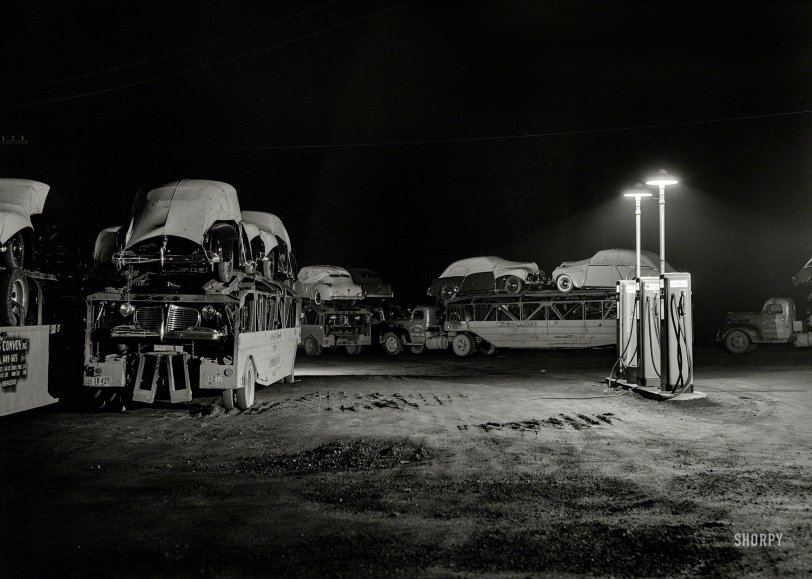


Framed or unframed, desk size to sofa size, printed by us in Arizona and Alabama since 2007. Explore now.
Shorpy is funded by you. Patreon contributors get an ad-free experience.
Learn more.

- Freeze Frame
- Texas Flyer wanted
- Just a Year Too Soon
- WWII -- Replacing men with women at the railroad crossing.
- Yes, Icing
- You kids drive me nuts!
- NOT An Easy Job
- I wonder
- Just add window boxes
- Icing Platform?
- Indiana Harbor Belt abides
- Freezing haze
- Corrections (for those who care)
- C&NW at Nelson
- Fallen Flags
- A dangerous job made worse
- Water Stop
- Passenger trains have right of way over freights?
- Coal
- Never ceases to amaze me.
- Still chuggin' (in model form)
- Great shot
- Westerly Breeze
- For the men, a trapeze
- Tickled
- Sense of loneliness ...
- 2 cents
- Charm City
- What an Outrage
- Brighton Park
Print Emporium
Night Moves: 1941

April 1941. "Auto convoy trucks at service station near Chicago." Medium format negative by Russell Lee for the Farm Security Administration. View full size.
New Automobiles
These were probably some of the last civilian autos produced in 1941. Car plants were converting to wartime production of everything but cars: jeeps, trucks, tanks, and even heavy bombers.
The railroads got smarter
It's true, the boxcars equipped for hauling autos were limited capacity, and it was easy to damage the merchandise. Things were so bad that by the end of the 1950s, the railroads had largely lost the new car trade.
However, by the mid 1960's the railroads were getting that work back. Today, a single, long multi level auto carrier with vandal resistant covering can carry 12 to 20 new cars. The highway auto carrier you see is delivering new cars to the dealers or wholesale/distributors from a railroad facility. (That is, unless you live close to an assembly plant.)
A solid train of auto racks can carry 800 or more new vehicles; that's a lot of trucks off the road.
'41 Plymouths
Looks like a load of '41 Plymouths. Whoever bought them would be probably holding onto them for a few years due to war production starting in '42. My wife's great uncle had a '42 Plymouth with no chrome trim. He still had it in his barn when he died about 5 years ago. Still had the last inspection tag on it from 1969.
Plymouths and Dodges
We see here an assortment of 1941 Plymouths and Dodges. The two cars on the back end of the truck on the left are Plymouths, and the two sedans in the back, on the backs of trucks (one is a light-colored sedan, covered with a tarp) are Dodges.
While trucks got larger, so did rail cars for auto transport. First, open cars that could carry as many as 15 cars, and later, the enclosed cars we see today, that deter vandalism and theft of parts during transport.
Fin-ish ahead of their time
Cars that can been seen well enough despite all the canvas look to be 1941 Dodge Custom Town Sedans. If you look closely at the rear of the first light-colored car from the left, you'll see a harbinger of Chrysler Corp. things to come: fins!
They Drive by Night ...
1940 movie with Humphrey Bogart, George Raft, Ida Lupino and Ann Sheridan.
Look Out, Railroads!
Looks fly-by-night, but it was the future. The railroads held most of this traffic at the time, but it was in specially-equipped boxcars that tended to hold just four autos. The truckers had the same capacity, but a faster transit time and the ability to deliver to the customer no matter where they were located.
Eventually the trucks got bigger.
























On Shorpy:
Today’s Top 5